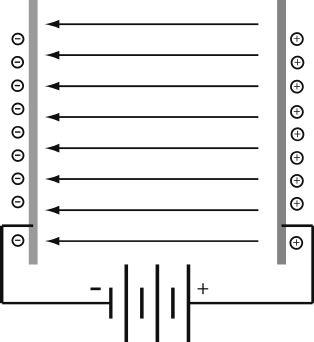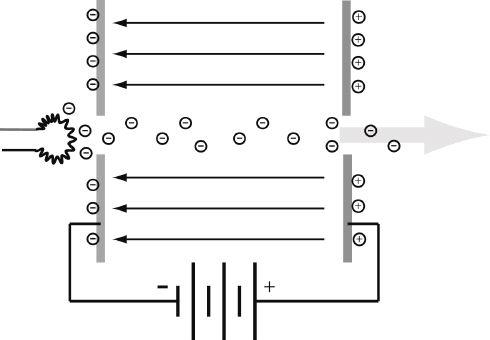Beyond the God Particle (26 page)
Read Beyond the God Particle Online
Authors: Leon M. Lederman,Christopher T. Hill
Tags: #Science, #Cosmology, #History, #Physics, #Nuclear, #General

A great debate ensued among physicists and philosophers as to what mediates the force “at a distance” between charges. There are no strings or springs or anything else visibly connecting them. This discussion in the early nineteenth century led to the concept of the electric field. The idea is
that any electric charge actually produces a field that surrounds it. This field falls off in strength, following Coulomb's inverse square law (like Newton's inverse square law for gravity). A distant electric charge, which is
coupled
to the field by virtue of having a charge, will experience the presence of the electric field in the sense that it will be attracted to or repelled by the field, depending upon the sign of its charge. The force experienced by an electric charge in an electric field is determined only by the value of the electric field where the electric charge is located. And the electric field itself is produced by other charges located somewhere else, such as in the copper plates that make up the particle accelerator itself. Very simple indeed (see discussion referenced in
note 15
).
This leads us to useful applications. One such application is to make a “uniform electric field.” We do this by taking two parallel plates of copper and connecting a battery to them (see
fig. 7.29
). The result is that electrons are sucked out of one plate (the one hooked up to the positive terminal of the battery) and deposited into the other plate (the one hooked up to the negative plate). This movement of electric charges halts when a large electric field builds up between the plates. The electric field is opposing the battery, pulling very strongly on the electrons, trying to yank them out of the copper plate that has a surplus of electrons, and move them back to the other copper plate that has a deficiency of electrons, i.e., to “re-neutralize” the system.
17
FIGURE 7.29. Uniform Electric Field.
A uniform electric field between parallel plates of copper to which an electromagnetic potential is applied by a battery (note the use of the conventional symbol for a battery with indicated + and – terminals). A surplus of electrons , –’s (deficiency of electrons , +’s) accumulates on the negative (positive) copper plate.
However, cold copper metal holds on dearly to electrons. The electric fields among the copper atoms themselves cause these electrons to stay in the metal, and it takes a very large external electric field, or some thermal energy, i.e., heat, to overcome it. If we heat the metal, we are essentially injecting a lot of energy into it, and through random collisions we will kick electrons out of the copper plate. An electric current will then begin to flow between the plates. Electric current is just the motion of many charges together in some direction, and the electric field will become diminished as the electrons balance out among the two plates. Incidentally, this is best done in a vacuum to avoid the complications of air. With air present, the current refuses to flow (air is a
resistor
to current flow) until, eventually, the air molecules break down in some random channel in the air (the molecules ionize, i.e., they lose their electrons). The air then becomes a
conductor
of electricity, and the current will then quickly flow between the copper plates through this conducting channel of ionized air. That's called a “bolt of lightning.”
If we set up our parallel plates in a vacuum, enormous uniform electric fields can be generated between the plates. Still, if the electric field becomes too great (perhaps about one hundred million volts per meter) the electrons will be ripped out of the copper (this is called “breakdown”), so we'll assume that we keep our electric fields below this critical level. Then, any lowly electron that is released into the vacuum at the negative plate will accelerate toward the positive plate and gain kinetic energy, like a rock in a slingshot.
We now have the basic ingredients needed to build a particle accelerator.
THE ELECTRON MICROSCOPE
The simplest charged particle accelerator, indeed, involves two parallel copper plates in a vacuum. We establish, using a power source of some kind, a large electric field between the plates. Then, by heating the plate with the surplus of electrons, we can coerce some of them to jump out of the copper. These will accelerate, by virtue of the electric field, toward the other plate. If we make a small hole in the positive plate to which they are accelerating, some electrons will pass through the hole, and voilà, we now have a beam of energetic accelerated electrons flying through space (see
fig. 7.30
).
FIGURE 7.30. Acceleration of Charged Particles.
A simple particle accelerator. Electrons are thermally ejected from a hot filament (zigzag loop on left) and pass through a hole in the negative plate. They are then accelerated in the electric field between the parallel plates toward the positive plate. They exit through a small hole, producing a particle beam with energy equal to the voltage difference applied to the plates by the battery (e.g., each electron acquires 12 electron volts of energy if we use a 12-volt battery). The system must be placed in a vacuum to allow the electrons to accelerate, unobstructed by collisions with air molecules.
This is a forerunner of most vacuum tubes that were used in early days of electronics. This ultimately led to the “picture tube” or “cathode-ray tube.” Indeed, the cathode-ray tube is a simple particle accelerator. We used to say that everyone had a particle accelerator in their living room—the TV picture tube—but today cathode-ray picture tubes have gone the way of the horse-drawn carriage and the steam locomotive (replaced by thin digital screens that use light-emitting diodes or plasmas). However, there remain many sophisticated variations on this idea.
The principle involved to produce the energetic beam of electrons would work for any charged particles: protons, ions of atoms (atoms missing an electron), muons (a heavy sister particle to the electron), etc. It is the most basic principle of electromagnetism: a negatively charged particle is attracted to a positively charged particle and is repelled by a negatively charged particle—the potential energy, or voltage difference, between the plates (energy that comes from the battery) is the analogy of the stretched band of the slingshot. As the particle is accelerated, it takes energy away from the plates and acquires energy of its own, “kinetic energy,” exactly like the rock in the slingshot acquires kinetic energy from the potential energy of the stretched sling. The cathode-ray picture tube employs about 20,000 volts power source, similar to that used in modern electron microscopes. The electrons are accelerated toward the screen of the picture tube and have been given 20,000 eV of energy each by the picture tube's “electron gun” (aka “particle accelerator”).
So we now have the desired first element of a microscope: a small probe particle, which is an accelerated electron, and its quantum wavelength is many thousands of times smaller than a visible photon. We can therefore build an electron microscope by using a beam of accelerated electrons. The quantum wavelength of electrons can be shrunk to many times smaller than a human cell, even down to the size of an atom.
Recall our basic microscope design principles: (1) Beam, (2) Target, (3) Detector (eyeball), (4) Computer (brain). Here we use the electron beam to illuminate a target, which contains a specimen that we want to examine. The electrons collide with the specimen and are scattered in all directions. We then use a clever array of electric fields (and even magnetic fields, discussed below) to make a lens that focuses the scattered electrons—the detector. “Electromagnetic lenses” play the same role as the glass lenses of Van Leeuwenhoek in an optical microscope. The lenses form a magnified image from the scattered electrons that have collided with the specimen. Since our eyeballs aren't designed to see electrons hitting our retina (not a good thing to do), we project the electrons onto a phosphorous screen, much like a TV picture tube (nowadays the electrons are detected in a silicon array and the data is processed by a computer). In this way we get a beautiful magnified image of our specimen.
An electron microscope has much greater magnifying power than an
optical microscope because electrons have quantum wavelengths that can easily be about 100,000 times shorter than visible light (photons). Electron microscopes can achieve magnifications of up to about 10,000,000×, whereas ordinary optical microscopes are limited by the wavelength of light to useful magnifications below 3,000×. What a spectacular new world opens up to the electron microscope!
18
Electron microscopes are used to observe a virtual infinity of biological and inorganic specimens. These include microorganisms, bacteria, viruses, plasmids, cells, large molecules, biopsy samples, metals, crystals, agricultural vegetable and soil samples, fragments from archaeological or geological sites, microelectronic circuits and chip fabrication as used in computers, forensic stuff from crime scenes—you name it. Industrially, the electron microscope is used for quality control and failure analysis—checking out the metal and rivets in the wings on aircraft and the support structures of buildings and bridges—studying how metals become fatigued in everything from gasoline engines to battery terminals. Modern electron microscopes usually don't use picture tube screen displays anymore and instead produce electron micrographs using specialized electron-detecting circuits (making pixels) and digital displays with computerized image-processing and image-capture capabilities. Fewer accelerated electrons with more computer image processing means the sample (target) life is longer, and even motion pictures become possible.
The social and economic impact of this, the simplest scientific particle accelerator known as the electron microscope, is profound and enormous. Since neither of the authors have PhDs in economics, we are reluctant to assign a dollar value to this, but we are sure it is many, many times what our nation is spending on basic research and the world's highest-energy particle accelerators today. This is a pure example of how investment in basic science has created and sustained our economy. What science has given to our economy and its standard of living through this simple device, the simplest of particle accelerators, the
electron microscope
, could probably have paid for many Super Colliders and most of the science funding in the world today.

“I don't know what good this will be, but one day you may tax it.” So said Michael Faraday to the Chancellor of the Exchequer, William Gladstone, who visited his lab to see where all that “wasteful spending” on physics was going. In Faraday's lab the money was going to develop wire and coils and batteries, or, in short, to invent “electricity.” Faraday studied the property of electrons interacting with electric and magnetic fields, the particle physics of his day, and he laid the groundwork for the post–steam engine Industrial Revolution, the modern era, based upon electricity.
1


